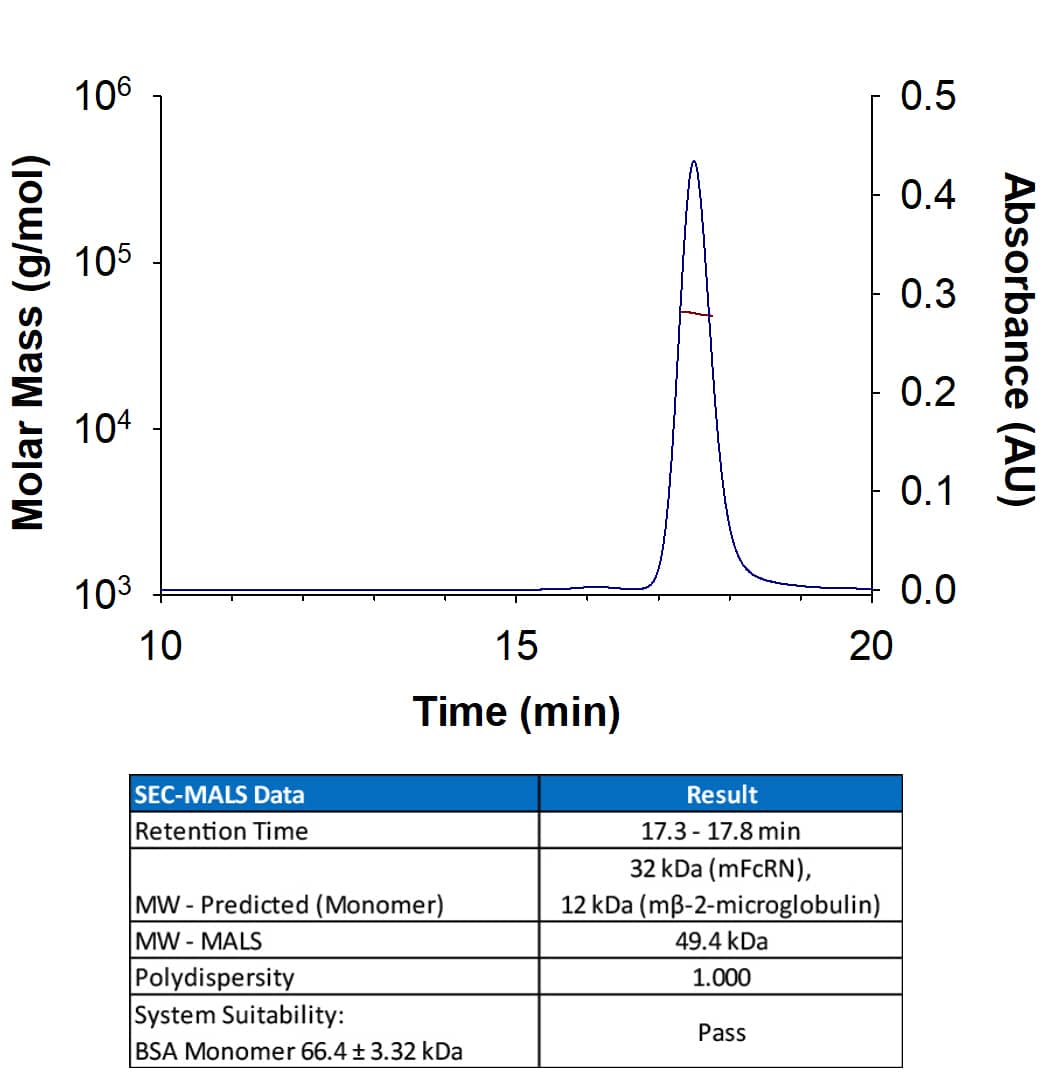Recombinant Mouse FCRN Heterodimer Protein, CF
R&D Systems, part of Bio-Techne | Catalog # 9114-FC
Analyzed by SEC-MALS. Non-covalently associated with endogenous beta 2-Microglobulin

Key Product Details
Source
NS0
Accession #
Structure / Form
Non-covalently linked heterodimer with endogenous mouse beta-2-microglobulin from NS0 cells.
Conjugate
Unconjugated
Applications
Bioactivity
Product Specifications
Source
Mouse myeloma cell line, NS0-derived mouse FCRN protein
Ser22-Ser301 with a C-terminal 6-His tag
Ser22-Ser301 with a C-terminal 6-His tag
Purity
>95%, by SDS-PAGE visualized with Silver Staining and quantitative densitometry by Coomassie® Blue Staining.
Endotoxin Level
<0.10 EU per 1 μg of the protein by the LAL method.
N-terminal Sequence Analysis
Ser22 (FcRN) & Ile21 ( beta-2-microglobulin)
Predicted Molecular Mass
32 kDa (mFcRN); 12 kDa (m beta-2-microglobulin)
SDS-PAGE
41-46 kDa (mFcRN); 9 - 12 kDa (m beta-2-microglobulin)
Activity
Measured by its binding ability in a functional ELISA.
When Recombinant Mouse FCRN is immobilized at 0.5 μg/mL (100 μL/well), the concentration of human IgG that produces 50% of the optimal binding response is found to be approximately 2-10 μg/mL.
When Recombinant Mouse FCRN is immobilized at 0.5 μg/mL (100 μL/well), the concentration of human IgG that produces 50% of the optimal binding response is found to be approximately 2-10 μg/mL.
Scientific Data Images for Recombinant Mouse FCRN Heterodimer Protein, CF
Recombinant Mouse FCRN Protein SEC-MALS.
Recombinant Mouse FCRN (Catalog # 9114-FC) has a molecular weight (MW) of 49.4 kDa as analyzed by SEC-MALS, suggesting that this protein is a heterodimer. MW may differ from predicted MW due to post-translational modifications (PTMs) present (i.e. Glycosylation).Formulation, Preparation and Storage
9114-FC
| Formulation | Lyophilized from a 0.2 μm filtered solution in PBS. |
| Reconstitution |
Reconstitute at 250 μg/mL in PBS.
|
| Shipping | The product is shipped at ambient temperature. Upon receipt, store it immediately at the temperature recommended below. |
| Stability & Storage | Use a manual defrost freezer and avoid repeated freeze-thaw cycles.
|
Background: FCRN
References
- Stapleton, N.M. et al. (2015) Immunol. Rev. 268:253.
- Pyzik, M. et al. (2015) J. Immunol. 194:4595.
- Ahouse, J.J. et al. (1993) J. Immunol. 151:6076.
- Ober, R.J. et al. (2001) Int. Immunol. 13:1551.
- Dickinson, B.L. et al. (1999) J. Clin. Invest. 104:903.
- Chaudhury, C. et al. (2003) J. Exp. Med. 197:315.
- Simister, N.E. and K.E. Mostov (1989) Nature 337:184.
- Kobayashi, N. et al. (2002) Am. J. Physiol. Renal Physiol. 282:F358.
- Praetor, A. and W. Hunziker (2002) J. Cell Sci. 115:2389.
- Zhu, X. et al. (2001) J. Immunol. 166:3266.
- Spiekermann, G.M. et al. (2002) J. Exp. Med. 1. Stapleton, N.M. et al. (2015) Immunol. Rev. 268:253.
- Firan, M. et al. (2001) Int. Immunol. 13:993.
- Sarav, M. et al. (2009) J. Am. Soc. Nephrol. 20:1941.
- Akilesh, S. et al. (2008) Proc. Natl. Acad. Sci. 105:967.
- Vidarsson, G. et al. (2006) Blood 108:3573.
- Qiao, S.-W. et al. (2008) Proc. Natl. Acad. Sci. 105:9337.
Long Name
Neonatal Fc Receptor
Alternate Names
FCGRT
Gene Symbol
FCGRT
UniProt
Additional FCRN Products
Product Documents for Recombinant Mouse FCRN Heterodimer Protein, CF
Product Specific Notices for Recombinant Mouse FCRN Heterodimer Protein, CF
For research use only
